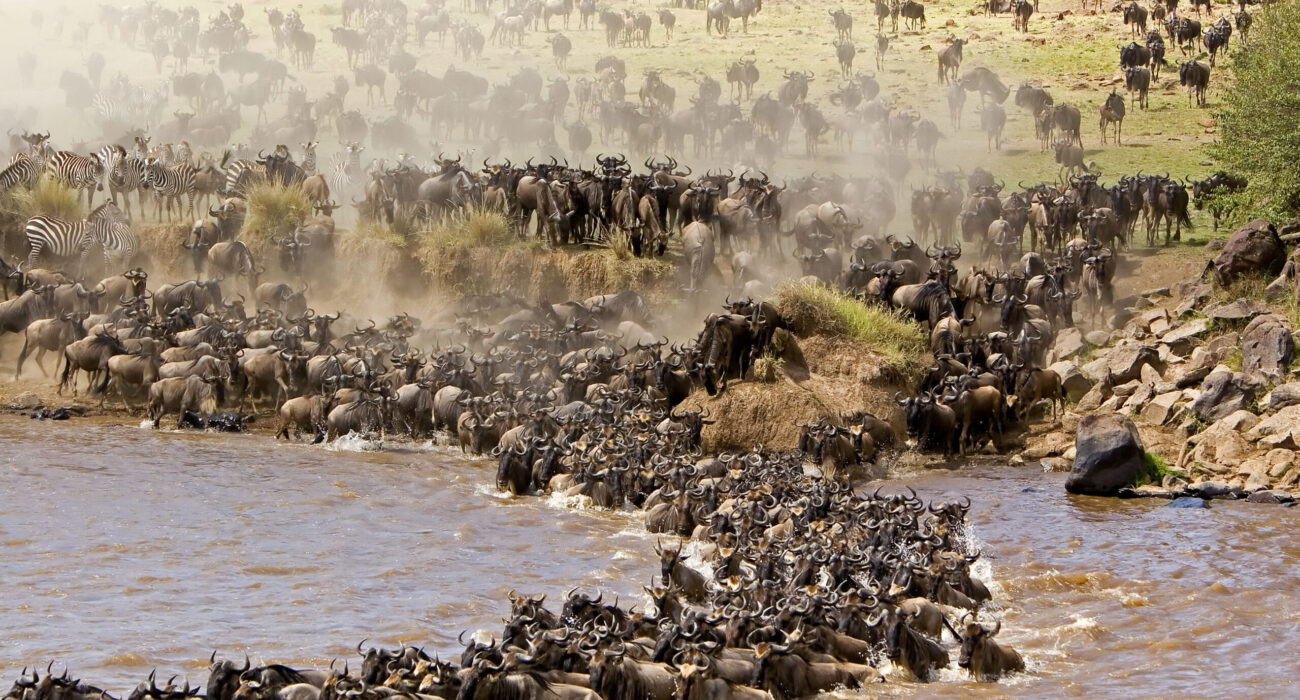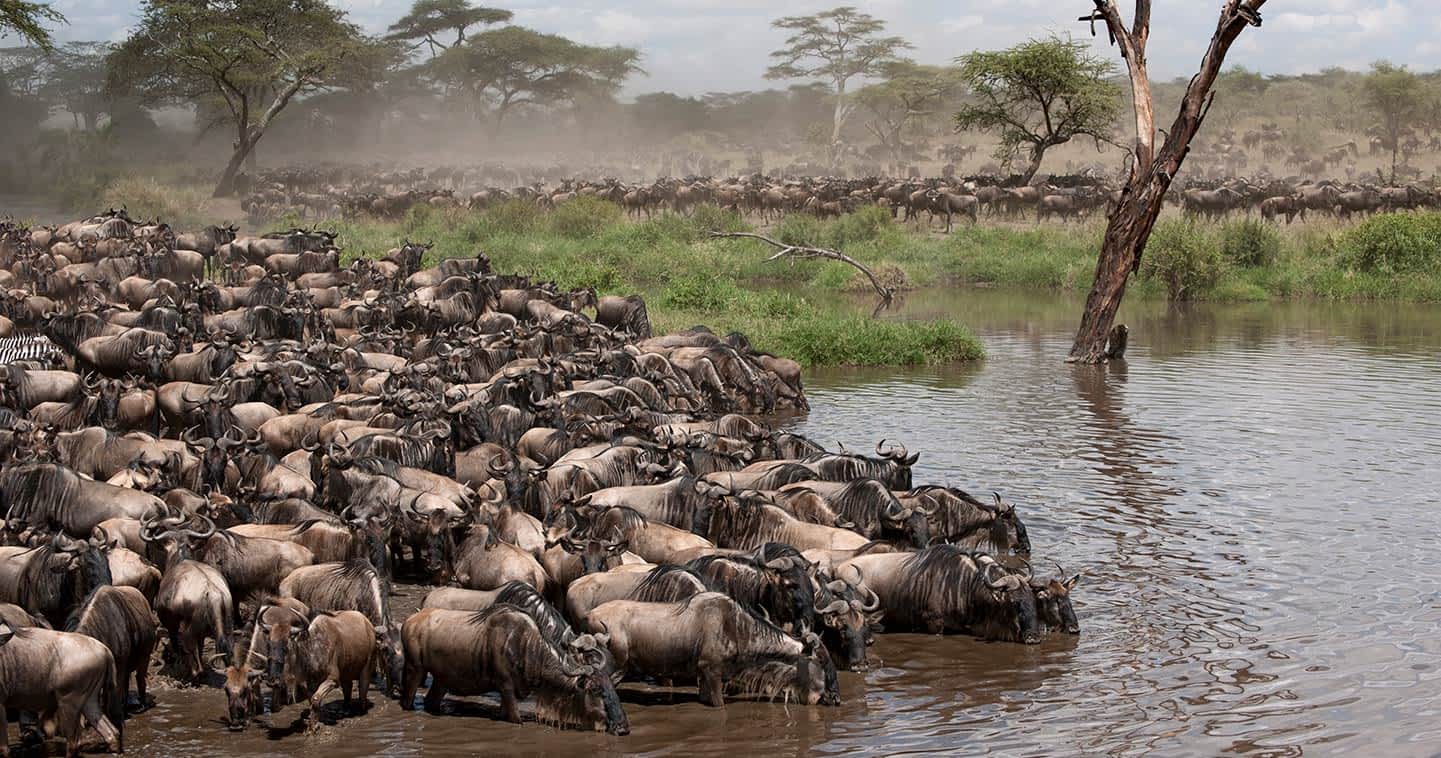
HIGHLIGHTS OF THE GREAT WILDEBEEST MIGRATION
CATEGORY: WILDLIFE SAFARI
Southern Serengeti| Ngorongoro Plains
 DURATION
DURATION
December to March and July to October
 PICK UP
PICK UP
Jomo Kenyatta International Airport
Tour Overview
The path of the migration sweeps from the southern Serengeti and Ngorongoro plains through the western savanna woodland. From there the animals head towards the north-western part of the greater Serengeti and Mara ecosystems, and back southwards through the eastern part of the parks and reserves.
Along this path, key events occur that are appealing to safari-goers, such as witnessing the thundering mass of animals, watching them cross the Mara River, the birth of their young, and the predators that accompany them.
Migration Species
Wildebeest make up 60% of the convoy’s volume, followed by zebras, Thomson’s gazelles and eland.
December to end March – The Ndutu Calving Season
Volumes of wildlife gather on the southern Serengeti and Ndutu plains. This is the best time to experience the sheer volume of the migration. The flat, green plains and uninterrupted views serve up one of the best opportunities to watch the massive movement of wildlife, and the core Ndutu and southern Serengeti areas are the best places to witness the spectacle.
January and February are the months of calving for the wildebeests. The wildebeest stop their constant run during this time and give birth to their young. Around 8,000 wildebeest calves are born every day during this time. Surprisingly the babies start running with the rest of the migrating herds just after a few hours of their birth. The newborns are fragile and easy targets for predators. Lions, cheetahs, hyenas and even jackals scramble for opportunities to fill their bellies. However, it is hype time for the predators; most of the calves get killed in the attack of these deadly hunters. The plains between Naabi Hill Gate in the north, Gol Kopjes to the east, Olduvai Gorge in the south and west to Maswa thrive with new life. Safaris offer nail-biting highlights at this point, with plenty of action that is not always suitable for the faint-hearted.
April to Mid July – Moving north
From April to June, once the bulk of their youngsters have found their feet, the herds continue their journey north in search of new grass. The long rains of April and May provide enough water and grazing for the animals to spread out over the entire southern Serengeti plains. From east to west they split up into smaller herds in a slow but definite move towards the north.
In April and May the heavens open and the Serengeti is showered daily with rain that manages to close many seasonal roads surrounding the area.
May and June make it into the top three best possible times to see herds on migration safaris (when the roads are open again). In June and July herds are harder to track on migration safaris, with the limited road network and Private Grumeti Reserve’s concession in the way.
Mid July to October – The Mara River Crossings
From July to September, migration safaris hold the excitement of herds crossing the Mara River. As the animals enter the water, individuals are taken by crocodiles. The wildebeest and zebras must survive the Nile crocodiles and fast-flowing water before facing the lions waiting on the other side. Their sacrifice secures the survival of this extraordinary journey of species. This time of the year game viewing is sensational, impressive, and dramatic. It is messy, and only the strong willed safari-goers can partake this adventure.
November to December – Moving South
By October, the animals have depleted the Mara plains of grass and the natural instinct that propels each one kicks in and has them venturing south once more to find fresh grazing. Remarkably, they arrive on the plains at Ndutu a few days after the first rain of the season has fallen. The herd leaves decent-enough grazing at Lobo and the Bologonja Springs and set off southwards again across the eastern and central savanna woodland.
Here, the animals spread out to areas with water and grazing that allow them to be within striking distance of the Ndutu lakes and plains. During this time predators often lurk in the Lobo grass. Will you see a lion strike? Only your migration safari experience will tell…
BEST TIME FOR ACTION FILLED SAFARI!!!
These two periods – December to March and July to October – are the best times to experience the most thrilling migration activity. Although the animals are still on the move during the months between and on either side of these times, they don’t offer particularly exciting viewing.

Safari Includes
- Park Entrance Fees
- Transport in a 4WD with an open roof
- Professional driver-guide
- Full board accommodation on sharing basis
- 1 liter of water per person per day
- Excursion as per the itinerary
- Full day game drive 8hrs game drive.
Safari Excludes
- Beverages and alcoholic drinks
- Items of personal nature
- Telephone bills
- International Flights ( From / To Home )
- Medical insurance
- Tips
CONTACTS



